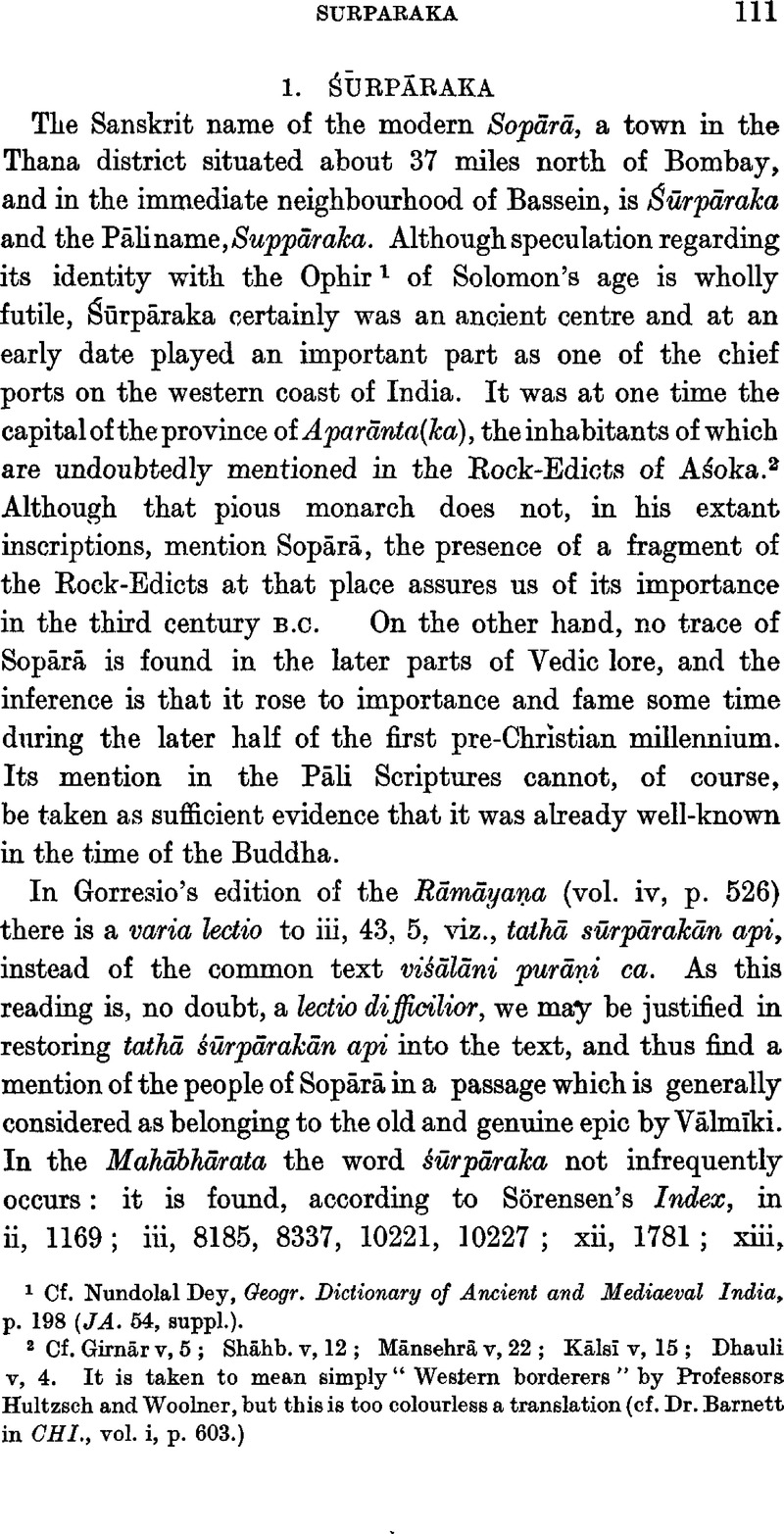No CrossRef data available.
Article contents
Abstract

- Type
- Miscellaneous Communications
- Information
- Copyright
- Copyright © The Royal Asiatic Society 1927
References
page 111 note 1 Cf. Dey, Nundolal, Geogr. Dictionary of Ancient and Mediaeval India, p. 198 (JA. 54, suppl.)Google Scholar.
page 111 note 2 Cf. Girnār v, 5; Shāhb. v, 12; Mānsehrā v, 22; Kālsī v, 15; Dhauli v, 4. It is taken to mean simply “Western borderers” by Professors Hultzsch and Woolner, but this is too colourless a translation (cf. Dr. Barnett in CHI., vol. i, p. 603.)
page 112 note 1 Cf. Macdonell, , Vedic Grammar, p. 142Google Scholar; Oldenberg, , Rgveda-Noten, ii, 74Google Scholar.
page 112 note 2 Cf. for the sense śevadhi- “a jewel, a treasury”.
page 112 note 3 Synonyms of vrndāraka are in the scholia to Pāṇ. ii, i, 66 (matallikā, macarcikā, prakāṇndam, etc.).
page 112 note 4 A singularly ineffective discussion on words in -pa- is found in Festschrift Jacobi, p. 27 sq.; śūrpa- is not even mentioned there.
page 113 note 1 Cf. Lassen, Indische Altertumslcunde I2, pp. 649, 678 sq.
page 113 note 2 This work is, unfortunately, not available to me here.
page 113 note 3 Cf. Wilson, , Catalogue of Mackenzie Coll., i, p. xcvGoogle Scholar; Taylor, , Catalogue raisonné, iii, 166Google Scholar; Graul, , Reise nach Ostindien iii, 226, etc.Google Scholar
page 113 note 4 Cf. Sonnerat, , Voyage, i, 165 sq.Google Scholar; Caland-Fokker, , Drie oude Portugeesche Verhandelingen over het Hindoeisme, p. 76Google Scholar; Taylor, , I.e., iii, 705Google Scholar; Wilson, , Works, ix, 24Google Scholar; Dubreuil, Jouveau, Archeologie, ii, 87, etc.Google Scholar
page 113 note 5 Śbr. xiv, i, 1 sq. Cf. Hopkin's, Indogerm. Jahrbuch, ii, 230Google Scholar; Festschrift Windisch.
page 113 note 6 Cf. Zachariæ, , Goett. Gel. Anzeigen, 1916, p. 591Google Scholar.
page 114 note 1 This is the MS. Sloane 1820 of which I have given a report in the Bull. School of Or. Stud., ii, 731 sq. In that paper and ibid., iii, 413 sq. I have proved that the renowned book of Baldseus is simply a plagiarism and lacks every ounce of original value.
page 114 note 2 Tamil karāiyan “white ant” (cf. Lettres édifiantes, xii, 102, 420; Dänische Missionsberichte, iv, 428).
page 115 note 1 Varāhamihira, , Brhatsaṃhitā, xiv, 14Google Scholar, mentions a mountain in the western region called Sūrpādri (this, and not sūryādri, is the lectio difficilior), it seems probable that this means the same as Sahyādri from which Paraśurāma shook or threw his Śūrpa.
page 115 note 2 Cf. RV. i, 117, 24; Pāṇini, vii, 2, 34.
page 115 note 3 Cf. Pāṇini, vii, 2, 19.
page 116 note 1 Cf. Avestan wytsty (i. e. vitasti-), Pers. bidast.
page 116 note 2 Cf. JASB. lxviii: part 1, p. 96 sq.; Bhandarhar Comm. Volume, p. 21.
page 116 note 3 Cf. also Macdonell-Keith, , Vedic Index, ii, 295Google Scholar.
page 116 note 4 The identification of Vitastā with λδσφης seems to originate with A. W. von Schlegel, cf. Indische Bibliothelc, ii, 303 sq. (Cf. Lassen, , De Pentapotamia Indica, p. 459Google Scholar.)
page 116 note 5 The name Birastes seems to denote an Iranian river, the Puraly, near Rambakia where Alexander founded a new Alexandria ν'ζρɛιταις. This is perhaps the Medus Hydaspes of Vergil, Georg. iv, 211 (cf. Pauly-Wissowa, , Realencyhlopadie, vol. ix, p. 39Google Scholar) although this seems to me very doubtful.
page 116 note 6 JASB. lxviii, i, p. 96, n 3.
page 116 note 7 Cf. Phihlogus Supplement x (1907), p. 248Google Scholar.
page 117 note 1 Pralcritgrammatik, § 207; Bezzenbergers Beiträge, vi, p. 93.
page 117 note 2 Cf. Morgenstierne, , Report on a Linguistic Mission to Afghanistan, p. 36, n. 1Google Scholar.
page 117 note 3 In this I quite agree with DrMorgenstierne, , I.e., p. 36Google Scholar.
page 119 note 1 Cf. Johansson, , Shāhbāzgarī, ii, p. 7 sq.Google Scholar.
page 120 note 1 Cf. Uhlenbeck, , Altind. etymol. Woerterbuch, p. 171Google Scholar; Persson, , Beiträge z. indogerm. Wortforschung i, 249Google Scholar; Scheftelowitz, , Festschrift Jacobi, p. 27, etcGoogle Scholar.
page 120 note 2 In this connexion a question may be allowed. Wha t is the word post(ā) meaning “poppy” and “capsules of poppy and a beverage prepared from them” (cf. SirGrierson's, GeorgeBihar Peasant Life, § 1,028Google Scholar, and Watt, , Economic Products of India, p. 845 sq.Google Scholar). Curiously enough, the word does not occur either in Hobson-Jobson or in Dalgado's Glossário Luso-Asiatico, though it is fairly frequent in older literature on India (cf. e.g., Bartoli, , Missione al Gran Mogor (ed. 1714), p. 64Google Scholar; De Laet, , De Imperio Magni Mogolis, p. 105Google Scholar; Monserrate, , Commentarius, ed. , Hosten, pp. 558, 642Google Scholar; Fryer, ed. Crooke, i, p. 92 (cf. p. 263), etc.




